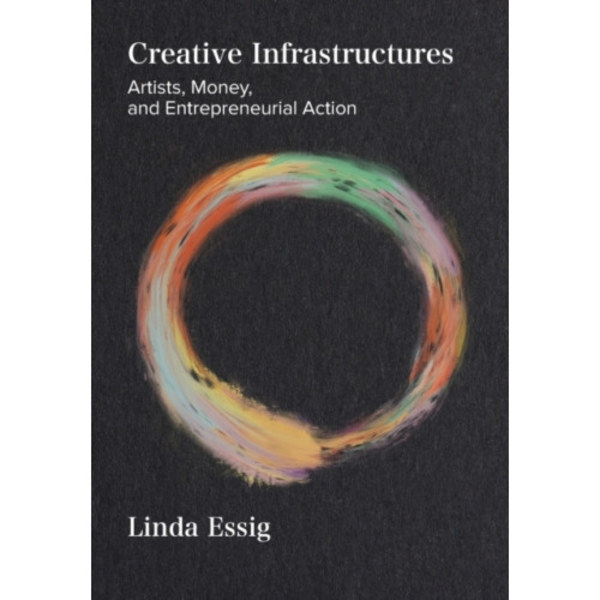
Creative Infrastructures (häftad, eng)
489 kr
489 kr
Fre, 11 jul - mån, 14 jul
Säker betalning
Nöjd kund-löfte
30 dagars öppet köp
Produktbeskrivning
Essig uses illustrative case studies to show how her theoretical framework explains a number of innovative efforts in culturally and racially diverse communities. The Ouroboros, the serpent eating its own tail, is a visual metaphor deployed by Essig in the opening essay to shift commonly held perspectives on, especially, the relationship between art and money.
Art is the head; money is the tail, feeding and nourishing the head in a cycle that enables the organism to not only survive but also thrive. Between the art and the money is the body: innovation and entrepreneurship. Innovation is understood to be a novel idea that is implemented and has impact on a domain.
For that is what the artist does: create something new and unique that has impact. Entrepreneurship is conceived of as the discovery or creation of a mediating structure that can convert the artistic innovation into capital (financial and other types) that can be re-invested in the artist and the making of more art.
This book endeavours to untie the knotty relationships between artists and entrepreneurship in order to answer the question 'How can artists make work and thrive in our late-capitalist society?'Other essays in the collection consider a range of topics including how aesthetic and cultural value are transmitted from the artist to the audience; the complexity of the tension between what art fundamentally is and the reproduction of that work and the recent foregrounding of the idea that art can produce positive social change – through current and late-twentieth-century trends in 'social impact art' or 'art for change'.
As in sports, business and other sectors, the star artists, the top 1 per cent, have disproportionately influenced the public expectations for what 'a successful artist' means. It isn’t necessary to retell the stories of the one per cent of arts entrepreneurs; instead Essig looks instead at the quotidian artist, at what they do and why, not what they make. All too often, artists who are attentive to the 'business' of their creative practice are accused of 'selling out'.
But for many working artists, that attention to business is what enables an artist to not just survive, but to thrive. When artists follow their mission, Essig contends that they don’t sell out, they spiral up by keeping mission at the forefront. The closing essay is a work of speculative fiction, based in all that comes before, both in the preceding essays and in Essig’s work as an artist, arts advocate and scholar of cultural policy.
Returning to the symbol of the Ouroboros, it connects the head (art) to the tail (not money specifically, but resources), and back again. It is a 'future imaginary', in which she profiles three fictional artists in the year 2050. The field of arts entrepreneurship is growing – thanks in large part to the work of Linda Essig.
The case studies in the book are US-based, but the issues addressed are universal. This book is ideal for use in training programmes for arts administrators and advocates; policy analysts and business schools that are looking to add in arts programmes. It will be of great interest and significance to people working in the cultural industries in the United Kingdom and Europe, especially Germany, where there has also been some recent research interest on similar topics.
It is also relevant to the many artists who participate in training and professional development programmes in their community, as well as those who are just starting out.
Format Häftad Omfång 202 sidor Språk Engelska Förlag Intellect Utgivningsdatum 2022-02-23 I
Vikt, gram
500
Artikel.nr.
1a4a9096-d3c6-4abc-8d4f-82a51076f89c
Fyndiq har inget eget lager utan arbetar med enskilda butiker som lagerhåller produkter i och utanför Sverige, Europeiska unionen (EU) och Europeiska ekonomiska samarbetsområdet (EES).
Din beställning skickas från respektive leverantörs eget lager under alla helgfria vardagar. Så snart din beställning är skickad får du en leveransbekräftelse på mejl.
Produkterna levereras till dig inom 1-21 arbetsdagar, beroende på produkt, antingen direkt i din brevlåda eller till ditt närmsta ombud. Om du beställt produkter från olika butiker så skickas de i separata paket.
Beräknat leveransdatum ser du alltid på produktkortet och i din beställningsbekräftelse.
Snabbare leverans
Snabbare leverans, uppges på produkter vars beräknad leveranstid är mellan 1-3 arbetsdagar
Fraktkostnad
Frakten kostar endast 29 kr! Det tillkommer inga ytterligare frakt- eller leveranskostnader efter köpet.
Creative Infrastructures (häftad, eng)
489 kr
489 kr
Fre, 11 jul - mån, 14 jul
Säker betalning
Nöjd kund-löfte
30 dagars öppet köp
Toppsäljare i kategorin

ny 1-pack MART La.bubu Spännande Plyschdockor Figur Leksaker Blind Boxes Färg Slumpmässig
126 kr
Tidigare lägsta pris:
135 kr

1 st LABUBU The Monsters Exciting Macaron Plyschdockor Figur Leksaker Blind Boxes (Färg Slumpmässig) 1 1 Single pack
128 kr

1-pack FÖR POP MART LABUBU Monster Spännande Macaron Plyschdocka Leksak Blind box (slumpmässig färg)-Perfekt Bxz
126 kr
Tidigare lägsta pris:
385 kr

Högkvalitativ POP MART LABUBU 3.0 Monster Spännande Macaron Plyschdocka Leksak Blind Box 1 st LABUBU 3.0 purple
138 kr

POP MART Labubu The Monsters – Big into Energy Series Blind Box 17 cm Vinylfigur | Samlarfigur | Designer Toy | Originalprodukt
199 kr

1-pack FÖR POP MART LABUBU Monster Spännande Macaron Plyschdocka Leksak Blind box (slumpmässig färg)-Perfekt Bxz
127 kr

3-Pack - iPhone 13 / 13 Pro - Härdat Glas Skärmskydd Transparent iPhone 13/13 Pro
49 kr

Rabubu blindbox 3.0Färg Slumpmässig
136 kr
Lashlift kit - Eyelash lift kit - Lashlift - Iconsign Transparent
159 kr

3-Pack - iPhone 15 Skärmskydd i Härdat Glas Transparent iPhone 15
49 kr